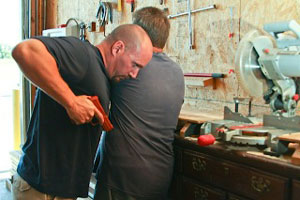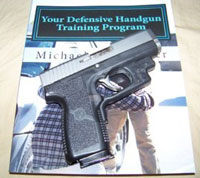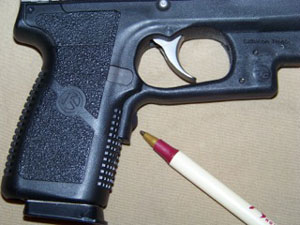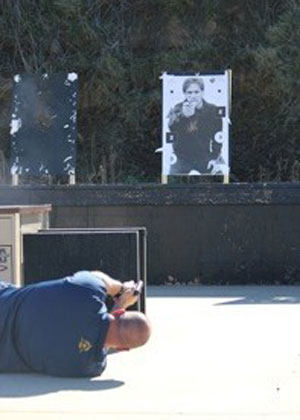SUMMARY: Mike Seeklander used to think laser sights were only for military usage, but now he’s got them on his concealed carry and home-defense guns. What are the benefits of laser sights on carry guns, and what should you look for in laser products? Mike explains all this and much more.
In the past, if you’d asked me about lasers on guns, I would have dismissed them almost immediately. I knew they had significant uses in military and other applications, especially when used in infrared mode. But for a civilian or even a law enforcement concealed carry gun, I would have considered them non-essential gear. I have to admit, I am biased in that I have very good vision and never needed something like a laser for assisted sighting. I also had a problem adding any device that made the gun harder to carry or that was potentially unreliable.

One of my home defense guns, equipped with Crimson Trace Lasergrip as well as Lightguard. This is a great set-up because now I have an integral light and laser sight combination on the gun.
However, if you look at my current carry gun, as well as my home-defense handgun, you’ll see right away that both have laser sights! One thing I have always told my students is that they should evolve. There’s an endless supply of information available related to gear, techniques, and tactics, and I am a big believer in changing things up if I find a better method or piece of gear that will improve my odds in a fight. And I evolved!
What changed my way of thinking about laser sights? Two things: The first was my experience with the products made by the company that gave me my first laser for a carry gun, Crimson Trace Corporation. The second came from doing a significant amount of close-quarters handgun training. Training in that context quickly showed me that having a laser gave me the advantage of always knowing where my impact would be when doing full-contact simulations with my training partners. In addition, research has always indicated that a person’s ability to bring their focus back to the front sight under extreme stress might be compromised, so the ability to stay focused on the threat might be a key advantage in a fight, and a weapon-mounted laser offers that advantage.
Full disclosure here: I speak very highly of Crimson Trace products for two reasons. First, they are quality and reliable products, and second, the company provided the lasers I first owned, tested, and began to carry. Having said that, I am sure there are other great products on the market, but my experience is with Crimson Trace products, and they will be my example.
My goals for this article are to:
* Educate you on the benefits of lasers on concealed carry guns, including the training benefits.
* Explain what I look for in laser products.
* Relay my method of zeroing a laser and using it for precision shots.
Benefits of Lasers sights on Carry Guns
Let’s discuss the “whys” of a laser on a carry gun. There are numerous positive aspects of having a laser on your carry gun, and honestly I can’t think of a downside if you are dedicated to training regularly with your iron sights as well. Let me break them down:
Lasers allow the user to stay focused on the threat.

With a weapon-mounted laser sights, the defender can easily drop the gun slightly and focus on the threat if necessary to help make a lethal-force decision. The laser dot is visible and indicates exactly where the gun is pointed. We are hard-wired to look at what is threatening us.
If you are a regular PDN reader, I don’t have to explain the details of what will happen under stress. The simple fact is that all of us are hard-wired to look at what is harming or going to harm us versus looking at a set of pistol sights at arm’s length. Being able to stay threat focused is a valuable side effect of having a laser on a gun. In my opinion, this is just as important before your lethal-force decision has been made, and you can stay focused on the person and what they are doing with their hands if you so choose. Once the decision to use lethal force has been made, with a visible laser there is no focal shift back to the front sight for a longer-range shot. This becomes even more of a benefit if your vision has deteriorated to the point where focusing on a front sight is very difficult, if not impossible. A laser on your carry gun is the solution!
Lasers allow the user to shoot from alternate positions where getting a sighted shot might be impossible.
This is difficult to train for, but imagine yourself in a grounded position between the rows of seats in a movie theater. In your downed position, you might not be able to extend your arms and get a sight picture on the threat. In this case, a laser would really shine, and as long as you keep the proper grip pressure on the gun, it can be shot from almost any position.
Lasers give the user immediate feedback on where the gun is actually pointed.
I state this based on the significant amount of close-range training I have done in recent years. On numerous occasions, I have been locked up with an opponent, in a loose position of control, and had some doubt about where my muzzle was actually pointed. This is even more common when on the ground with an opponent. A handgun laser gives immediate feedback as to where the gun is pointed. This is critical to ensure you are not pointing the gun at yourself! In the fast-paced environment of a physical fight where you are trying to get the handgun into play, this might be very important.

Having a laser on the gun will be a big benefit in an extreme close-range shooting position where the combatants are in some sort of clinch. The impact of the bullet will be known instead of guessed at.
In some cases this feedback is important not only to you, but it might also cause the person you are pointing the gun at to recognize what is going on. I don’t advocate using laser sights purposefully to intimidate a potential threat, but I know of more than one incident in which a visible laser on the center of someone’s chest caused them to have second thoughts about what they were doing. One individual I spoke to recently told me how he and a family member were followed and approached by multiple attackers in a parking garage. The defenders produced carry guns, and the laser dots on the attackers’ chests were enough to convince the attackers they were making a mistake, and they fled the scene.
Selecting a Laser Sight

My current carry gun with Crimson Trace Laserguard. The laser is small, lightweight, and required very little modification of my holster to allow me to carry it.
What do I look for when selecting a laser? Several key considerations stand out, each of which is important.
Lightweight and carry-friendly.
I need to have a product that will fit on a carry gun and allow me to carry like I normally do. My primary carry gun is a Kahr CW9, and I mounted a Crimson Trace Laserguard to it. The only modification I had to make was a slight one to my holster.

Activation button is on the front of the grip. I strongly believe that a well-designed handgun laser should have a button that is activated by my normal gripping process and will work with either hand.

Another switch that can be activated by gripping the handgun, again with either hand. This switch is on the back of the grip panel and takes very little pressure to activate.
Activated with an integral switch with one hand only.
I want a laser (and light) that is activated by the same processes that I would go through during the draw process, and with one hand only if that is all I get on the gun. The Crimson Trace Laserguard is activated by a small button switch on the front of the grip of the handgun, so the laser is activated while I am gripping the gun with either hand. The laser is immediately activated during my normal draw and grip process. If I have to respond to a spontaneous attack, I don’t want to deal with complicated switches to turn my handgun laser on.
Securely mounted and able to hold a good zero.
Because I might have to rely on just the laser to make a shot, the last thing I want is to have any uncertainty about the accuracy of the laser relating to where the bullet will land. I have to know it is going to hold zero.
Zero the laser parallel to the bore of the handgun.
What I mean by this is that I zero my handgun laser on a handgun so that the laser and barrel are parallel. From one inch to 100 yards, if theoretically bullet drop did not occur, the impact of the bullet would always be consistent. For example, the Crimson Trace laser I carry on my Kahr is mounted on the rail of the gun and sits about an inch below the bore of the handgun. Since I have the laser zeroed so it is parallel to the bore, if I have to take a shot at any given range where my handgun round is effective (0 to 50 yards), there should be no appreciable drop in the bullet. This means that no matter what my distance to the threat is, my bullet will land one inch above the laser dot. A combat-effective hit on the chest or body ranges from three to six inches in size, so as long as the laser is within that area and I do my job, the bullet will go where I need it to.
In comparison, some like to sight their lasers in so that the device works similar to an optic on a rifle. They zero the laser for an exact point of impact at a key distance. The problem with this method of zeroing is that this causes the laser to be at a slight angle compared to the bore, and if the shot has to be taken at any distance other than the one sighted in at, the person firing the gun may have to do some mental math to take a precise shot. At handgun fighting ranges, this may not be a huge problem, yet it is one I prefer to avoid.
Train with the laser in all positions and conditions.
When you get your laser zeroed, your next job is to train with it. You might be surprised to find that in very bright daylight conditions, the laser dot is difficult to see. In other conditions, it will be very easy to see. Your goal should be to learn how to shoot effectively with the laser yet have the ability to switch to your handgun sights if the laser fails or is not visible. Next you should focus on using the laser in non-standard positions. This will give you confidence in using your laser sights in a position where you will not be able to get your eyes behind the sights or get the gun into a standard shooting position.

Simulated on the range, this is a perfect example of the possibility that you might have to shoot from a grounded position, specifically one where you might not be able to get a normal extension of the gun and sight picture.
Another great benefit of training with a laser sight on your gun is that it will give you better feedback than just the sights themselves. You will be able to see movement of the gun that is translated through the laser, allowing you to better refine your shooting techniques and stabilization of the gun. This side benefit will really be noticeable when you are practicing movement techniques.
In closing, I advocate using a laser on a carry gun. If you select the right laser sight, zero it properly, and train with it, you will reap the benefits. Any device that gives you an advantage in a fight to protect your life or those of your loved ones is worth much more than what you pay for it!
Special thanks to Crimson Trace for providing the Laserguards used in this article.

Thank you for the life saving information you have provided for us, our loved one's and the safety for others around us. The only thing left to do is Practice! Practice! and never stop Practicing. Robert
This was a great article, very informative in detail! My first carry pistol (PK380) has a laser which has been helpful in accurate shooting! 30 years ago sighting a target was simple, now I need all the help I can get! As my Grandad once told me "I have a weak back, a weak knee and a weaker mind", when they all kick in at the same time I'm in trouble! His sight never diminished as mine has, (at 80 he could kill quail @40+ yards). "Zeroing in parallel" makes much more sense as I have been concerned with distance also. Keep up your good work, Hugh
My EDC is a Beretta sub compact, Crimson Trace does not make a laser suitable for this weapon to carry without having to buy an awkward fitting holster. most holsters don't allow concealed carry for this model Beretta.
Turning on a properly adjusted laser allows you to see the point of impact if you fire. This is great for training but it also allows an opponent to see where you are. Judgement is needed, IMO, for a decision to turn the laser on. That having been said, I found your article very interesting and through. Great work!
I have lasers on almost all of my handguns and long guns. Talking about handguns in close-range targets only, I have laser boresighted them all according to the recommendations given (parallel to the barrel) although, at short distances, the usual factory zeroing to 50 feet will not make a significant difference, (and at least with Crimson Trace products, I have found their sighting pretty accurate). However, if you think you might ever take a shot where a bad guy is holding a loved one, and only his head or part of his head is clear as a target, you'd better confirm your sighting and laser alignment with a good graduated target at a shooting range. This will also allow you to judge if you can hold a gun steady enough to miss your loved one's head, and if you can, to judge the tightness of your grouping to insure that any shot will not "wander" into the wrong person's head.
I see you don't monetize your site, don't waste your traffic, you can earn additional cash every month because you've got high quality content. If you want to know how to make extra bucks, search for: best adsense alternative Wrastain's tools
Extremely informative. I am a current gun owner and considering a gun with laser. Now I'm convinced that it's the best way to go. Thank you again for this article.
Crimson Trace may be a good product but I don't want to have take out a second or third Mortgage to pay for one. I am having trouble finding a regular holster to fit my Laser Max site however. I think I'm going to have to start carrying in a gun fanny pack.
I would write a nice long article with pics and all about crimson trace too, if they gave me laser sights for free.
Anyone who truly knows the fundamentals of handgun shooting will enjoy a lazer. In a true self defense situation the lazer will only be an asset. Most SD shootings occurr at less than 15-20 feet. Try one, you won't believe how much better & faster you'll be. Ever notice what a good shot you are with a flashlight or a garden hose? Your hand/eye coordination kicks in automatically & adjusts point of aim. Same principle as a tracer round. Great product!